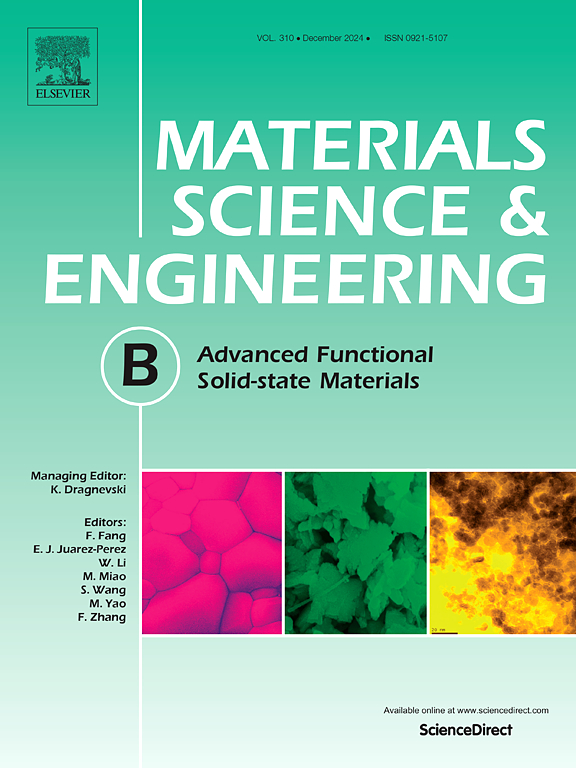Unveiling the photocatalytic activities of morphology-controlled ZrO2, BaO, and Y2O3 nanoparticles using Eucalyptus leaf extract
IF 3.9
3区 材料科学
Q2 MATERIALS SCIENCE, MULTIDISCIPLINARY
引用次数: 0
Abstract
This study investigates the synthesis of transition metal oxide nanoparticles, including Zirconium oxide (ZrO2), Barium oxide (BaO), and Yttrium oxide (Y2O3), using Eucalyptus leaf extract as a green reducing agent through a sonication-assisted approach. The nanoparticles were thoroughly characterized for their crystalline structure, functional groups, morphology, and elemental composition. The results confirmed the successful formation of distinct metal oxide bonds and unique morphological features: ZrO2 exhibited semi-spherical shapes, BaO showed monodisperse spherical morphology, and Y2O3 displayed a flaky non-spherical structure. The photocatalytic activity of the nanoparticles was evaluated for the degradation of Brilliant Blue (BB) and Rhodamine B (RhB) dyes. Among the samples, BaO nanoparticles achieved the highest degradation efficiency, reaching up to 99 % for both dyes under natural sunlight. Antibacterial studies revealed significant activity, with BaO exhibiting 18 mm and 21 mm inhibition zones against E. coli and S. aureus. Real-time turbidimetric growth inhibition tests further demonstrated BaO’s superior performance, with growth inhibition rates of 81.4 % and 88.6 % against E. coli and S. aureus. Additionally, antioxidant activity assessed through the DPPH assay indicated that BaO nanoparticles exhibited the highest radical scavenging ability, surpassing ZrO2 and Y2O3. These findings underscore the multifunctional capabilities of BaO nanoparticles, particularly in environmental remediation applications such as dye degradation, antibacterial treatments, and antioxidant activity, highlighting their potential for sustainable and eco-friendly solutions to pressing biological and ecological challenges.
揭示了桉树叶提取物的ZrO2、BaO和Y2O3纳米颗粒的光催化活性
本研究以桉树叶提取物为绿色还原剂,通过超声辅助方法合成过渡金属氧化物纳米颗粒,包括氧化锆(ZrO2)、氧化钡(BaO)和氧化钇(Y2O3)。对纳米颗粒的晶体结构、官能团、形态和元素组成进行了全面表征。结果证实了不同金属氧化物键的成功形成和独特的形态特征:ZrO2呈半球形,BaO呈单分散球形,Y2O3呈片状非球形结构。考察了纳米粒子对亮蓝(BB)和罗丹明B (RhB)染料的光催化活性。其中,BaO纳米颗粒在自然光照下对两种染料的降解效率最高,达到99%。抗菌研究显示,BaO对大肠杆菌和金黄色葡萄球菌的抑制区分别为18 mm和21 mm。实时比浊法生长抑制实验进一步证实了BaO的优良性能,对大肠杆菌和金黄色葡萄球菌的生长抑制率分别为81.4%和88.6%。此外,通过DPPH实验评估的抗氧化活性表明,BaO纳米颗粒具有最高的自由基清除能力,超过了ZrO2和Y2O3。这些发现强调了BaO纳米颗粒的多功能能力,特别是在染料降解、抗菌处理和抗氧化活性等环境修复应用方面,突出了它们在解决紧迫的生物和生态挑战方面的可持续和环保解决方案的潜力。
本文章由计算机程序翻译,如有差异,请以英文原文为准。
求助全文
约1分钟内获得全文
求助全文
来源期刊

Materials Science and Engineering: B
工程技术-材料科学:综合
CiteScore
5.60
自引率
2.80%
发文量
481
审稿时长
3.5 months
期刊介绍:
The journal provides an international medium for the publication of theoretical and experimental studies and reviews related to the electronic, electrochemical, ionic, magnetic, optical, and biosensing properties of solid state materials in bulk, thin film and particulate forms. Papers dealing with synthesis, processing, characterization, structure, physical properties and computational aspects of nano-crystalline, crystalline, amorphous and glassy forms of ceramics, semiconductors, layered insertion compounds, low-dimensional compounds and systems, fast-ion conductors, polymers and dielectrics are viewed as suitable for publication. Articles focused on nano-structured aspects of these advanced solid-state materials will also be considered suitable.
 求助内容:
求助内容: 应助结果提醒方式:
应助结果提醒方式:


